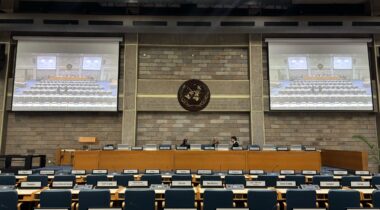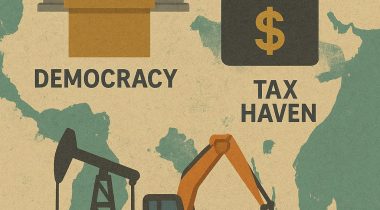
Andres Knobel ■ The unexploited silver bullet to tackle enablers: mandatory disclosure rules

Introduction
There are several typical transparency tools to help address illicit financial flows related to tax abuse, money laundering or corruption. Some are old, some are new, but for the most part they have included measures like filing of tax returns, publication of companies’ accounts, filing information on corporate owners and beneficial owners, automatic exchange of bank account information, exchange of tax rulings, transfer pricing documentation, and country by country reports. They all shed light on disclosing either the situation before an illicit financial flow may have taken place, or the outcome after it. They can also include a partial snapshot of what is currently taking place.
However, making sense of all of this information can be challenging. It is up to tax or money laundering authorities and other stakeholders to connect the various pieces of data reported by taxpayers in order to understand what has happened, and why or how, so they can challenge it. It’s similar to a magician’s trick. If you see a dove fly out of a magician’s hat, even though you know it is just a trick, you may not quite be able to figure out how it was done.
Consider the situation where a company declares zero taxable profit, with consequently no taxes payable. At first glance, it might suggest tax avoidance or evasion, but that may not necessarily be the case and there may be a good reason for it: for instance, in the case of a tourism company that was about to go bankrupt during Covid-19 lockdown. However, in other cases, for example when a successful multinational declares zero taxable income, that may be more suspicious. Still, proving there was some kind of tax abuse scheme in operation is extremely challenging, not least because of the lack of comparable prices of goods and services exchanged between independent companies, or because of the sheer complexity of the transactions or relationships involved in the scheme.
Even if authorities received more “data” on how these prices were determined or why a complex transaction was necessary, understanding it and being able to challenge it is a completely different story. In practice it can be extremely difficult to distinguish between business practices and transactions that have commercial substance and those that are rather artificially crafted just to reduce tax payments; to differentiate substance over form; or whether a transaction lays claim to tax benefits that were never intended by the rules. Even if authorities are able to eventually understand and object to a transaction or scheme, they need to spend considerable time and resources against armies of accountants and lawyers ready to bury them with confusing or irrelevant documents.
Imagine if instead authorities could simply ask these enablers to disclose not just the schemes they are promoting and engaging in to reduce taxes for their clients, but also the precise details on how the schemes work (the transactions, the parties involved, as well as the legal frameworks that apply). What’s more, imagine if authorities could even obtain the list of taxpayers who are using these schemes. It would be the equivalent to asking a magician to reveal their tricks.
It sounds too good to be true, but that is precisely what mandatory disclosure regimes are all about. Disclosing both the schemes and the taxpayers who used them would significantly improve the compliance risk management particularly of larger multinationals and high net worth individuals, by helping tax authorities to understand the relative risks posed by the respective taxpayers, and by being better able to target corporate audit plans. This can actually decrease the compliance costs for those taxpayers who have not engaged in the higher risk schemes.
A short history
Mandatory disclosure regimes are not new. Countries including the US and Canada have been implementing them since the 1980s, especially to target mass promotion of tax abusive schemes (eg “acquire this type of land, say that it was worth more than what you paid for it, and then get a higher tax deduction”). It was only when the OECD’s Base Erosion and Profit Shifting measure promoted mandatory disclosure rules under BEPS Action Point 12 that mandatory disclosure regimes got a revival. Although this Action 12 is not among the minimum requirements required by the OECD to be implemented (so most countries feel no pressure to adopt them), the EU established a framework for mandatory disclosure rules related to tax avoidance under the amendment to the Directive on Administrative Cooperation, known as DAC 6.
More narrowly, the OECD has also published its own version of mandatory disclosure rules in relation to schemes designed to circumvent the automatic exchange of bank account information (under the Common Reporting Standard or CRS) or to hide the beneficial owner behind opaque structures. While the EU also incorporated these schemes related to avoiding automatic exchanges and hiding the beneficial owner into its framework (DAC6), not many other countries have followed.
Despite the OECD focus on automatic exchange of information, mandatory disclosure rules about schemes to hide the beneficial owner are extremely relevant for beneficial ownership transparency, regardless of whether or not it is also related to circumventing automatic exchange of information. Close to 100 jurisdictions have beneficial ownership registration laws and face several challenges in verifying information. Mandatory disclosure rules could help improve verification and tackle complex ownership structures used to hide or confuse the identity of the beneficial owner, such as the abuse of trusts.
Why it is important
According to the Tax Justice Network’s State of Tax Justice Report published in 2021, multinational corporations were shifting an estimated US$1.19 trillion worth of profit into tax havens a year, causing governments around the world to lose US$312 billion a year in direct tax revenue. These illicit financial flows often rely on complex schemes that are difficult to prosecute for criminal evasion, but nonetheless are considered abusive and illegal by the tax administration.
Indicator 13 of the Corporate Tax Haven Index which assesses whether jurisdictions require the disclosure of tax schemes, explains why this is important: “First, the reporting requirements help tax administrations to identify areas of uncertainty in the tax law that may need clarification or legislative improvements. Second, providing the tax administration with early information about tax avoidance schemes allows it to assess the risks schemes pose before the tax assessment is made and to focus audits more efficiently. Third, requiring mandatory reporting of tax schemes is likely to deter taxpayers from using these tax schemes because they know there are higher chances that files will be flagged, exposed and assessed accordingly. Fourth, such mandatory reporting may reduce the supply of these schemes by altering the economics of tax avoidance of their providers because a) they will be more exposed to claims of promoting aggressive tax schemes, increasing the risk of reputational damage, and b) their profits and rate of return on the promotion of these schemes is likely to be reduced because schemes are closed down more quickly. This is all the more true if contingency fees are part of contracts.”
A new guide on mandatory disclosure rules
Together with Katrina Petrosovich, I have co-authored a 2022 publication by Apex Consulting (commissioned by GIZ on behalf of the German Ministry for Economic Cooperation and Development, known as BMZ) that provides extensive guidance on mandatory disclosure rules. It analyses and reviews the EU and OECD standards as well as the frameworks implemented by 9 countries (Argentina, Canada, Germany, Guernsey, Mexico, Portugal, South Africa, the UK and the US). It also reviews the attempts of other countries that have tried to implement disclosure regimes (eg Brazil, Colombia and Ecuador). The guidance offers an explanation and description of the possible options for:
- Who must report (eg enablers and/or taxpayers);
- The scope of reportable cross-border arrangements;
- The scope of taxes covered by the disclosure regime (eg “any tax” or only income and capital gains tax);
- The hallmarks of reportable arrangements (eg confidentiality, premium fee, hybrids, use of non-cooperative jurisdictions, etc);
- When information must be reported (eg before promotion, before implementation, etc);
- Possible grouping of arrangements and taxpayers (eg issuing a scheme ID);
- What information must be reported (eg list of taxpayers, details of the scheme, involved legal frameworks, etc);
- How to file information; and
- Consequences of compliance and non-compliance.
The guidance also recommends best practices based on lessons learnt and the challenges faced by implementing countries, such as:
- Requiring both enablers and taxpayers to report information;
- Requiring information to be reported as soon as possible, eg before promotion of the scheme;
- Requiring enablers to alert taxpayers that the scheme has not been approved by the tax authority;
- Requiring reporting of a list of taxpayers and scheme identifiers to easily match them,
- Establishing electronic reporting to allow for live analysis of the most common schemes, most common taxes or regulations involved, and the identity of the most popular enablers (in terms of number of clients, etc). This would allow tax authorities to promptly address the risks, by changing regulations, alerting taxpayers to the risks, or demanding enablers stop promoting abusive schemes;
- Establishing dynamic lists (regularly updated), especially “black lists” of abusive schemes that should be banned (eg not promoted or implemented) as well as “white lists” (schemes that are considered legal and valid by the tax administration that need not be reported);
- Addressing the issue of professional confidentiality and client-attorney privilege to prevent future legal challenges;
- Monitoring avoidance schemes (eg Mexico used thresholds for “personalised” schemes below which schemes need not be reported. In response enablers started re-classifying “general” schemes as “personalised” in order to avoid reporting them.)
The guide can be downloaded here. It will contribute to promoting the adoption of mandatory disclosure regimes in all countries, both to tackle tax abuse as well as secrecy. There is also an Excel document with a reference to the specific legal provisions in each of the countries reviewed.
It won’t be easy – but it’s doable
Writing a law to establish a mandatory disclosure regime may be easy. But withstanding the opposition from the private sector (enablers) is not. Based on the experience of other countries, lawyers, accountants, tax planners and corporate service providers will lobby lawmakers, file lawsuits to declare that the reporting regime is unconstitutional, invoke client-attorney privilege, professional secrecy and anything else they may come up with (including potentially high compliance costs).
Facing this opposition won’t be easy. It will require more awareness-raising campaigns, a wider adoption by more countries, and training for authorities and the judiciary on the importance and legality of these schemes.
There are success stories that mandatory disclosure rules can be based on. For instance, most financial institutions and professionals are considered “obliged entities” bound by anti-money laundering recommendations (although lawyers in some countries are still able to circumvent this). This means that most financial institutions must already report to authorities (eg the financial intelligence unit) whenever there is a suspicion of money laundering or financing of terrorism. In the EU, financial institutions are also required to report discrepancies to the local beneficial ownership registries. Indeed, mandatory disclosure rules have been implemented in some countries for decades.
Conceptually, one could indeed argue that the promoters of tax schemes should have no problem disclosing them. If indeed their purpose is simply to minimise the amount of tax payable through legal constructs then disclosure could hardly be seen as a threat to their business.
Conclusion
Authorities have access to a trove of data, but it’s often hard to interpret or use it to tackle illicit financial flows. The best complement to the pieces of information to which authorities already have access (eg tax returns, financial statements, account balance and income held in offshore banks, etc) is to require enablers to disclose, describe and explain schemes they are promoting and implementing that allow taxpayers to abuse the tax system, as well as individuals to hide their ownership of legal vehicles.
Lawyers and accountants will of course oppose this, but many countries have already succeeded in implementing these information regimes. The wider the use of mandatory disclosure rules, the more they will become accepted (as has happened with the most recent transparency advances that were initially resisted). Asking enablers to reveal their tricks is not just a direct contribution to tackling illicit financial flows, it can even work indirectly, by discouraging enablers and taxpayers from engaging in these schemes to begin with, if only to avoid the cost of reporting.
Downloads:
Related articles

The tax justice stories that defined 2025

2025: The year tax justice became part of the world’s problem-solving infrastructure

Bled dry: The gendered impact of tax abuse, illicit financial flows and debt in Africa

Indicator deep dive: ‘patent box regimes’

‘Illicit financial flows as a definition is the elephant in the room’ — India at the UN tax negotiations

Tackling Profit Shifting in the Oil and Gas Sector for a Just Transition

Follow the money: Rethinking geographical risk assessment in money laundering

Democracy, Natural Resources, and the use of Tax Havens by Firms in Emerging Markets


